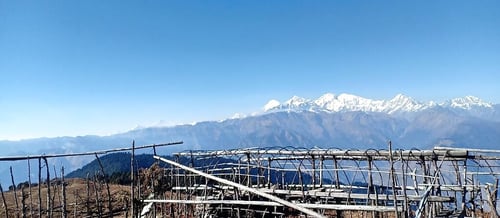Your journey begins with a scenic drive from Kathmandu to Dhunche, the entry point to the Langtang region. The route winds through the northwestern hills, passing lush terraced fields, traditional villages, and dense forests. Following the Trishuli River, you’ll be treated to stunning views of cascading waterfalls and distant snow-capped peaks. Dhunche, the administrative hub of Rasuwa district, is home to the Tamang community, known for their Tibetan-influenced culture, ancient Buddhist monasteries, and warm hospitality.
Transportation: Kathmandu to Dhunche by Local Bus
Accommodation: Local Teahouse in sharing room with common toilet/bath
Your trek kicks off with a gradual walk along a motor road, keeping the rushing Trishuli River to your left. The trail diverts at Thulo Bharkhu, leading to a steady ascent through pine forests toward Brabal, a small Tamang settlement with traditional stone houses. From Brabal, the trail descends through tranquil woodlands, where the fresh scent of pine fills the air, eventually reaching Thulo Syabru (2,250m). This charming ridge-top village is renowned for its apple orchards, rich Tibetan-influenced culture, and vibrant Buddhist traditions.
Accommodation: Local Teahouse in sharing room with common toilet/bath
The day begins with a challenging ascent as you leave Thulo Syabru behind. The steep uphill trail winds through dense forests, offering occasional glimpses of the Langtang Himal and Ganesh Himal ranges. As you climb higher, the vegetation transitions from lush greenery to more open landscapes. The trek leads to Mulkharka, a traditional Tamang village perched at about 3,000 meters. This small settlement provides a peaceful resting spot, where trekkers can immerse themselves in the rich Tamang culture while enjoying breathtaking mountain views.
Accommodation: Local Teahouse in sharing room with common toilet/bath
Another demanding day awaits as you continue your steep uphill ascent towards Lauribinayak. The trail takes you through rhododendron and pine forests, gradually opening up to alpine meadows. Midway, you stop at Cholang Pati, a small resting point that offer stunning views of the surrounding peaks. As you approach Lauribinayak, the landscape becomes more rugged, with panoramic vistas of Langtang Lirung, the Langtang Himal range, and Ganesh Himal unfolding before you. Lauribinayak, perched on a ridge, is known for its awe-inspiring mountain scenery, making it a rewarding stop after a strenuous climb.
Accommodation: Local Teahouse in sharing room with common toilet/bath
The trail features a mix of gradual climbs and a few steep ascents, offering breathtaking views of the Langtang and Ganesh Himal ranges along the way. Upon reaching Gosaikunda, a sacred alpine lake surrounded by rugged peaks, trekkers can enjoy lunch while soaking in the serene atmosphere. For those interested, an optional hike to the viewpoint at 4,610m provides a stunning panoramic view of the lake and surrounding landscapes. After exploring, the trek retraces its path back to Lauribinayak, where we rest for the night.
Accommodation: Local Teahouse in sharing room with common toilet/bath
The descent from Lauribinayak begins with a steep downhill walk through alpine terrain and dense forests. The trail leads to Chandanbari, a small settlement known for its monastery and yak cheese production. Afterward, the descent continues through rhododendron and pine forests until we reach the Trishuli River. Crossing the river, we follow the motor road leading to Dhunche, marking the completion of the trekking loop.
Accommodation: Local Teahouse in sharing room with common toilet/bath
Early in the morning, the return journey to Kathmandu begins, following the same winding mountain roads. The drive offers a final chance to admire Nepal’s diverse landscapes, from the towering Himalayan foothills to terraced farmlands and picturesque hillside villages. Arriving in Kathmandu, the trip concludes with memories of the breathtaking Gisaikunda Lake.
Transportation: Dhunche to Pokhara by Public Bus
Disclaimer: The description may not be completely accurate due to potential changes in terrain, weather conditions, government rules, flight etc. On any unavoidable circumstance your guide might suggest or make necessary changes on the route such as but not limited to, health issues, natural hazard, cancellation/delays on flights, blockage etc. Every effort will be made to ensure that the trip runs as planned but cannot be guaranteed.

